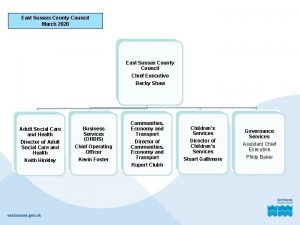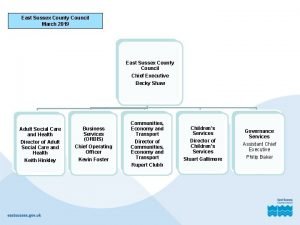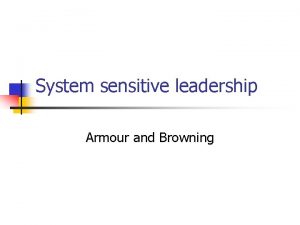Transforming Local Policing OFFICIAL SENSITIVE Sussex Local Policing















- Slides: 15

Transforming Local Policing

OFFICIAL – SENSITIVE Sussex Local Policing Model Two years ago, we set out the vision for Local Policing in Sussex Introducing the new Local Policing Model for Sussex Police OFFICIAL – SENSITIVE 2

Looking to 2020 Vision Transformation themes Sussex Police in 2020 3

The range of policing services Funding £ 12 bn Sussex budget £ 250 m Council tax Government grant Local policing vs Force services £ 250 m £ 27. 5 M savings target for local policing Sussex Police in 2020 4

Our Change Journey for Local Policing Changes to Command 2015/16 PCSOs Local Investigations 2016/17 Criminal Justice Resolution Centre 2017/18 Investigations framework £ 14 M savings delivered to date Sussex Police in 2020 Public Protection Prevention 2018/19 Response £ 14 M savings remaining 5

OFFICIAL – SENSITIVE Local Leadership – Pooling Skills and Breaking-down Silos The new Prevention model encompasses six local policing areas with a District Commander for each. CI Rosie Ross Crawley & Mid Sussex CI Miles Ockwell Adur, Worthing & Horsham CI Steve Curry Hastings & Rother CI Emma Brice Eastbourne, Lewes & Wealden CI Justin Burtenshaw Arun & Chichester Sussex Police CI Chris Veale Brighton & Hove OFFICIAL – SENSITIVE 6

OFFICIAL – SENSITIVE Completing the Local Policing Model Protect & prioritise our Response emergency service and implement a Resolution Centre to improve the service for victims and witnesses Focus our Investigation and Criminal Justice resources on the most vulnerable victims and invest in public protection Sussex Police public a t n e implem ing model d n a e Polic Agre n o lving. i t o s n e m v d Pre proble focuses on that Transform the PCSO role to provide a more effective presence in the community OFFICIAL – SENSITIVE 7

PCSOs – keeping people safe and reducing crime Implemented June 2016 “The ability to take statements has been very valuable as it not only enables PCSO’s to assist in problem solving but it can be useful to assist in incidents where multiple statements need to be taken. ” Current PCSO INSERT IMAGE Flexible problem solving in communities with 14% of incidents being solved by PCSOs outside of their home hub PCSOs are now completing a range of basic investigations providing a more efficient and effective victim service PCSOs are keeping witnesses and partners updated on progress cases, contributing to an improvement in police/public relations. PCSOs now have eight enhanced powers and have undergone extensive training around health, well-being and fitness. One of our new PCSOs has taken the lead for troublesome car cruise activity and is working with businesses and partners, providing community reassurance and planning multiagency operations to disrupt the activity. Impact of the new PCSOs in Crawley Sussex Police in 2020 8

Impact of the new PCSOs in Crawley Feedback from current PCSOs • There have been some excellent examples of how the PCSOs have worked together to problem solve i. e. tackling with partners the causes of issues such as anti-social behaviour in Maidenbower Crawley. The team tackled it via a problem solving file and worked with Crawley Borough Council ASB teams and community groups. • The PCSOs have worked on Op Treasure which is the disruption of the Organised Crime Group dealing drugs in Crawley town centre. Having a positive impact on making the town a safer place for residents and visitors. • 2 new PCSO’s were called to an incident in Ladbrokes in Crawley Town Centre in relation to an aggressive male. They immediately recognised Op Treasure nominals within Ladbrokes, and identified that they had been dealing there on a daily basis since activity under the banner of Op Treasure had caused them to be displaced from Memorial gardens. This has been crucial intelligence with regard to the activity of the nominals and in planning further operations. • Following the report of a 2 year old having fallen from a first floor window, 2 PCSO’s attended the scene. They secured the scene and started to take details prior to the arrival of SIU officers. Further members of the team despite being about to go off duty, attended to assist and commenced H 2 H enquiries, assisting with scene guard and filming of the scene. • Following an assault the suspect(s) were arrested nearby to the scene. Owing to the language barrier, one of our new PCSO’s who is Romanian attended the location and assisted the attending officers by translating for them and making the process a far easier and smoother experience. • “No allocated patch. Having all PCSO’s responsible for the whole district rather than individual areas I think does work better. Often when work would come in for your patch while on a rest days or leave, it would remain untouched. Now all jobs are allocated evenly and is also in my opinion developing closer team working. ” Sussex Police in 2020 • “Having PCSO’s take control of ongoing problems and investigating them is hugely beneficial. ” • “I feel the new shift pattern works well as it balances the week out well and enables us to work more efficiently. The old pattern would see a week of early shifts and would often present issues if the jobs we were dealing with could only be dealt with in the evening. ” 9

Resolving problems and focusing our investigative effort Implemented December 2016 Introduction of a new Resolution Centre able to efficiently and effectively deal with victim incidents Percentage of callers who were satisfied with their Resolution Centre experience 98% Percentage of respondents contacted within 48 hours of initial interaction with the Resolution Centre Percentage of cases that are resolved within the Resolution Centre on an annual basis 89% Over 70% 73% Percentage of respondents who fully understood the reasoning behind the next course of action that would be taken The police have finite resources so it is only right that we focus our efforts on the most vulnerable, considering threat, risk and harm. We should investigate when it is proportionate and in the public interest. CID Inspector Sussex Police in 2020 10

Response – being there when you need us most Implementation in April 2017 Prioritising our emergency service Smarter deployment Technology enabled Protection of Response Police Constable numbers Officers retaining a caseload, providing swifter victim outcomes Controllers empowered to deploy the most appropriate unit to an incident Sussex Police in 2020 11

Investigation – focused enquiries into cases which cause most harm Implemented in January 2017 Flexible investigations teams working out of six hubs: Hastings, Eastbourne, Brighton, Worthing, Chichester and Crawley Integration of offender management Improved efficiency through retention of file build by investigators Additional investment in Community Investigations teams Focusing effort on the right cases Percentage of front line local policing staff who have been trained on use of the Investigations Framework Sussex Police in 2020 80% 12

Investing in Public Protection of the most vulnerable in society Implementation in December 2017 75 Specialist investigators being recruited to deal with child sexual exploitation, rapes, sexual assaults and associated safeguarding Increased reporting of crimes including rapes, serious sexual assaults and domestic abuse suggesting increased public confidence in the police May 2017 Recruitment of 45 investigators June 2017 Defining roles for remaining Investigators On-going Recruitment of 30 investigators Optimisation initiative example – MASH review We will be reviewing and redesigning police resourcing and processes within our Multi-Agency Safeguarding Hub’s (MASH). We are looking to expand the current remit of what services our MASHs’ offer and see how far initial assessment processes can be developed with partners to improve efficiency and effectiveness whilst removing unnecessary duplication Sussex Police in 2020 On-going Delivery of twelve optimisation initiatives December 2017 Implementation completed 13

The New Prevention Model: Key Features OFFICIAL – SENSITIVE Intelligence Community Engagement Community engagement will be focused on increasing Officers in communities will gather intelligence to confidence in policing support the local policing activity It is an ongoing process enabled by the use of a wide range of Information and intelligence will be shared existing channels, such as social media that enhance visibility appropriately to enable more effective in the community partnership working ‘In the Know’ is an essential tool, however all Intelligence need to ensure that the correct engagement Community tools are used to meet the target sections of Engagement the community Community engagement will enable the Prevention teams to gather local community intelligence Policing within the Community Problem Solving Problem solving will be at the core of Prevention will be the main hub for problem solving activity All Staff and Officers will all be involved in problem solving activity Problem profiles will be used to gather intelligence and identify the best way to engage with vulnerable communities Work will be prioritised on the basis of threat, harm, risk and vulnerability Best practice will be shared using Prospero and other methods Sussex Police Problem Solving Partnership Working Enforcement The Prevention activity includes a dedicated enforcement capability Prevention Enforcement Officers will be deployed flexibly to support the Prevention work Officers support PCSOs, especially when enforcement action is required OFFICIAL – SENSITIVE Partnership Working The Partnership Decision Model (PDM) provides a clear framework that will enable the Prevention teams to engage with Partners locally, guided by a common set of expectations and SLAs (e. g. Parish Council SLA and the Draft LAT SLA) The Prevention teams will focus on working closely with local partners, negotiating with them regarding what tasks each organisation should be doing, recognising partners financial pressures 14

Prevention – a multi-layered approach Implementation to be completed by November 2017 Layer 1 – PCSOs are working together with partners to resolve problems that harm communities. They are more responsive and flexible. Layer 2 – We will dedicate a proportionate number of neighbourhood police officers to our most vulnerable locations. Layer 3 – A renewed focus on proactive, preventative policing Sussex Police in 2020 As this layer has now been implemented, a post implementation review is taking place assessing the effectiveness of the change and its impact on community engagement, service provision and victim outcomes. This layer has been designed with a focus on victim outcomes and public service provision – focusing officers back on the core mission of proactive, preventative policing. In developing the design we held partner engagement sessions, and internal workshops with staff and completed an eight week piece of detailed demand analysis outlining what activities prevention teams currently perform and how they can be most effectively utilised in the future. 15
 Official compendia list
Official compendia list Sussex county health department
Sussex county health department Adam doyle nhs
Adam doyle nhs West sussex
West sussex Feudal system anglo saxons
Feudal system anglo saxons Process governance
Process governance Sussex msk partnership
Sussex msk partnership Sussex pledge
Sussex pledge Mark stainton east sussex
Mark stainton east sussex Sussex pledge
Sussex pledge Safeguarding east sussex
Safeguarding east sussex Fire risk assessment east sussex
Fire risk assessment east sussex Sussex and wessex
Sussex and wessex Health education kent surrey and sussex
Health education kent surrey and sussex Beowulf time period
Beowulf time period West sussex lado
West sussex lado




























